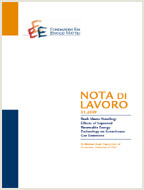Why Wind Is Not Coal: On the Economics of Electricity

05.04.2014
Lion Hirth, Falko Ueckerdt, Ottmar Edenhofer
Q42, D61, C61
Power Generation, Electricity Sector, Integrated Assessment Modeling, Variable Renewables, Integration Costs, Welfare Economics, Power Economics, Levelized Electricity Cost, Grid Parity
Energy: Resources and Markets
Giuseppe Sammarco
The economics of electricity is shaped by its physics. A well know example is the non-storability of electricity that causes its price to fluctuate widely. More generally, physical constraints cause electricity to be a heterogeneous good along three dimensions – time, space, and lead-time. Consequently, different generation technologies, such as coal and wind power, produce different economic goods that have a different marginal economic value. Welfare maximization or competitiveness analyses that ignore heterogeneity deliver biased estimates. This paper provides an analytical welfare-economic framework that accounts for heterogeneity for unbiased assessments of power generators. The framework offers a rigorous interpretation of commonly used cost indicators such as ‘levelized electricity costs’ and ‘grid parity’. Heterogeneity is relevant for all generators, but especially for variable renewables such as wind and solar power. We propose a definition of ‘variability’, derive the opportunity costs of variability, and link that concept to the ‘integration cost’ literature. A literature review shows that variability can reduce the value of wind power by 20-50%. Thus it is crucial that economic analysis accounts for the physics of electricity.
***
Suggested citation: Hirth, L., F. Ueckerdt, O. Edenhofer, (2014), ‘Why Wind Is Not Coal: On the Economics of Electricity’, Nota di Lavoro 39.2014, Milan, Italy: Fondazione Eni Enrico Mattei.
